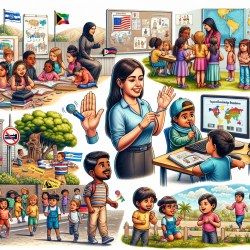Introduction
In the realm of speech-language pathology, creating positive outcomes for children often requires a holistic approach that encompasses understanding their environments and the challenges they face. The recent study titled Exposure to Neighborhood Violence and Gun Carrying Among Adolescents in the United States: Findings From A Population-Based Study sheds light on a critical issue affecting adolescents today. By delving into the data, we can uncover valuable insights that can inform practitioners and guide interventions aimed at reducing gun carrying among adolescents.
Understanding the Study
The study examines the association between exposure to neighborhood violence (NV) and gun carrying among adolescents, using data from the 2021 Youth Risk Behavior Survey. The findings reveal that adolescents exposed to NV have more than double the odds of carrying a gun compared to their peers who are not exposed. This underscores the importance of addressing environmental factors when designing interventions for at-risk youth.
Key Findings and Implications
- Exposure to NV: Adolescents exposed to NV are significantly more likely to carry guns. This highlights the need for community-based interventions that address violence and provide safe environments for children.
- Parental Monitoring: High parental monitoring is a protective factor against gun carrying. Encouraging parental involvement and education can be crucial in reducing risky behaviors among adolescents.
- Demographic Factors: Male adolescents and non-Hispanic Black adolescents are more likely to carry guns, indicating the need for targeted interventions that consider cultural and demographic contexts.
- Substance Use: Alcohol, cigarette smoking, and opioid misuse are associated with increased gun carrying. Integrating substance use prevention into intervention programs can enhance their effectiveness.
Implementing Data-Driven Strategies
For practitioners working with adolescents, integrating these findings into practice can enhance the effectiveness of interventions. Here are some strategies to consider:
- Trauma-Informed Approaches: Implement trauma-informed practices in schools to support students exposed to NV. This can include training for teachers and staff to recognize and address trauma-related behaviors.
- Parental Engagement Programs: Develop programs that educate parents on the importance of monitoring and engaging with their children. This can be done through workshops, counseling sessions, and community events.
- Cultural Competency Training: Equip practitioners with the skills to understand and address the unique needs of diverse populations, ensuring that interventions are culturally sensitive and effective.
- Substance Use Education: Incorporate substance use education into therapy sessions, highlighting the risks associated with gun carrying and substance misuse.
Encouraging Further Research
While the study provides valuable insights, it also opens the door for further research. Practitioners are encouraged to explore additional factors that may influence gun carrying and develop innovative interventions tailored to their specific communities. Collaboration with researchers can lead to more comprehensive studies that address the complexities of adolescent behavior and environmental influences.
Conclusion
By leveraging data-driven insights, practitioners can make informed decisions that lead to better outcomes for adolescents. Understanding the impact of neighborhood violence and other risk factors is crucial in developing effective interventions. Together, we can create safer environments and empower adolescents to thrive.
To read the original research paper, please follow this link: Exposure to Neighborhood Violence and Gun Carrying Among Adolescents in the United States: Findings From A Population-Based Study.










